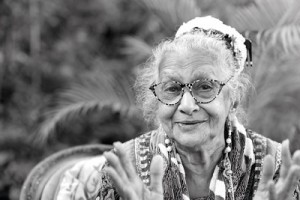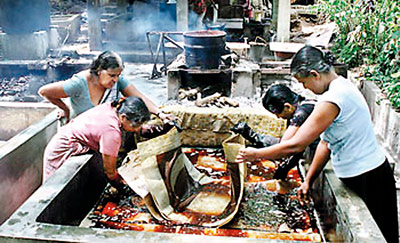She inspired, she empowered
Life was an adventure for Ena de Silva. Even if you had never met her or stepped into her legendary home, you would know something of this pioneering and incredibly charming woman who passed away last weekend, peacefully at home in her beloved Aluwihare at the grand old age of 93.

Ena de Silva: Unforgettable in every way. Photograph courtesy Dominic Sansoni -threeblindmen
Ena was of a generation who stamped their mark on Sri Lanka’s history by making bold strides in art, architecture and design.
She is closely associated with Geoffrey Bawa, Ulrik Plesner and Barbara Sansoni…who changed the trajectory of their disciplines, with their trailblazing embodiment of modernity with an island spirit.
Ena’s work in textiles complemented theirs and adorns several of the country’s most remarkable structures.
The daughter of the first Ceylonese Inspector General of Police Richard Aluwihare and Lucille Moonemalle, Ena grew up in a cultured society. She married Osmund de Silva, who would later be the IGP after her father.
Her colourful personality and undeniable talent led her to the acquaintance of Bawa, Plesner and Sansoni, each powerhouses in their own way.
With their input- Bawa’s in particular – Ena began experimenting with textiles and batik, a technique that she helped to popularise in Sri Lanka.
| “Ena was a wonderful organiser. She would spontaneously put together dinners, organise trips to the jungle…her ability to get things going was remarkable.” Laki Senanayake |
In the 60s she opened shop with Laki Senanayake, Prof. Reggie Siriwardena and her son Anil Gamini Jayasuriya; they worked hard, creating remarkable batik pieces including the tapestries at the Oberoi, the ceiling at the Bentota Beach Hotel and the banners that hang in Parliament.
Following Osmund’s death Ena moved back to her ancestral home in Aluwihare in the 80s, where she continued work with the Aluwihare Heritage Centre (she had opened a batik factory in Aluwihare in 1964).
They experimented with batik dyeing techniques, moving on to needlework.
Chandra Aluwihare, who joined as a young girl fresh out of school in 1965, still remembers Ena’s determination to involve and empower as many young women as she could from the area-at a time when such things were not celebrated the way they are today.
“We were all so intrigued with what Aunty was doing that I joined immediately after I left school,” she says.

Women working at the Aluwihare Heritage centre. File pic by M.A. Pushpa Kumara
“Those of us who were taught how to use the batik technique loved it – it was so new to us, and she ensured that we learnt everything thoroughly, with a good background in business and practicality.”
Chandra remembers meeting Bawa, who would regularly visit the centre with Ena. The Aluwihare Heritage Centre was immensely successful in reviving the art of batik on a larger scale at a time when it was dying, inspiring others in the vicinity to start up their own businesses.
Not satisfied with what she had accomplished already, Ena also opened a carpentry and brass foundry for young men in the area during the 80s.
This proved to be vital in keeping the town of Aluwihare out of trouble during the JVP insurrection – gainfully employed young men were much less likely to create trouble than those that weren’t.
This is a sentiment echoed by her nephew Rajiva Wijesinha, who says that while his aunt was not a creature of politics, “she didn’t really like discussing it”, she was very politically aware.
| “We were all so intrigued with what Aunty was doing that I joined immediately after I left school” Chandra Aluwihare |
Ena was not satisfied with an armchair role, however. “She kept those boys out of trouble,” he says. Wijesinha too remembers his aunt the way most do- an extremely colourful personality who lived life on her own terms.
“She got on very well with the younger generation,” he says. “She would call everyone darling, and involve us all in her life. She was a remarkable person.”
He visited her for her birthday last month- Ena was not well- to share a few pictures of a trip to China and remembers her saying, “don’t be sad darling, we had such good times.”
She’s remembered with a great deal of fondness by her contemporaries too.
Those we spoke to all shared the same sentiments-“what a wonderful person she was,” they said. Laki Senanayake, artist and sculptor was Ena’s business partner at one point and remained her dear friend.
“Ena was a wonderful organiser,” he says. “She would spontaneously put together dinners, organise trips to the jungle…her ability to get things going was remarkable.”
Architects like Channa Daswatte and Amila de Mel share similar memories of their encounters with Ena.
“I met her as an architecture student,” remembers de Mel (who is also involved with restoring Ena’s famed Alfred Place residence at Lunuganga) “and since then I have visited her numerous times.
She was so involved in everything she did and it was inspiring to me, especially as a young architect.”
Daswatte, who made Ena’s acquaintance through C. Anjalendran recalled the first time he met her- just before her daughter’s wedding. She was so gracious and spirited.
I remember in particular she was wearing this brown, embroidered number- the pallu was in the design of a painting her daughter had done as a child.
| “I have this one clear memory of Ena at Kandalama, installing a giant 8-foot version of an elephant that she designed for the hotel. Ena was right in the midst, climbing up a ladder in her sneakers and fully engaging with the workers” Channa Daswatte |
You couldn’t possibly forget meeting Ena de Silva.” Daswatte also remembers her perseverance and commitment to projects that she took on.
“I have this one clear memory of Ena at Kandalama, installing a giant 8-foot version of an elephant that she designed for the hotel.
While it was being installed Ena was right in the midst, climbing up a ladder in her sneakers and fully engaging with the workers. She wanted perfection and ensured that her clients got the best.”
Architect Ismeth Raheem who spent a lot of time in Ena’s company, especially when she moved to Matale describing her as “one of those one in a million women!” says, “Ena was interested in so many things.
You could sit with her and have a conversation about books and we used to have a telescope to look at the stars. She could easily identify a number of trees and flowers and birds.
She was also interested in sports and we watched numerous World Cup matches. My wife and I would accompany her on regular trips to Yala, and we celebrated birthdays at her Aluwihare home.
When my daughter was doing some research in Matale she stayed at Ena’s and was so well taken care of. She was very generous and always very knowledgeable – I often think that she would have been a brilliant academic.”
Architect Anura Ratnavibhushana met Ena when he was a hopeful young architect with Bawa and took a shine to her immediately. “She was an utterly gracious and fearlessly stylish lady-absolutely original.”
Ena’s greatest contribution was to the craftspeople that she empowered through her work, he says. “She was fastidious and practical, and very ruthless when it came to assessing her own work.
Ena was so proud of her heritage and I think young people today can learn from that.”
Chandra Aluwihare, for her part, hopes that Ena’s legacy will inspire a new generation of young women to make strides in spite of establishment that may stand in their way.
“She inspired us and treated us like her own children. Until she fell ill Aunty would visit us regularly and talk to us, making sure we were doing well. We’ll all miss her and will try our best to keep up her work.”
Ena de Silva is survived by her daughter Anula Kusum Gilmour, daughter-in-law Averill Jayasuriya, son-in-law David Gilmour and granddaughter Shanika Gilmour.


